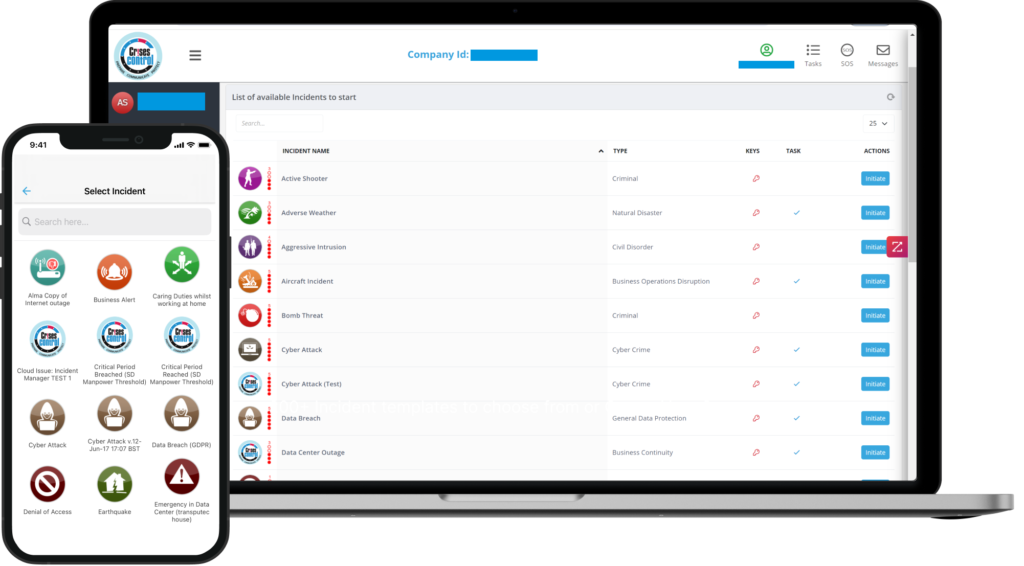Ever had that sinking feeling when the internet drops dead right before a crucial presentation? Or maybe it’s a late-night email informing you of a security breach. Incidents, big or small, can leave businesses scrambling. But what if there was a way to transform chaos into calm control?
This blog explores the power of incident management, specifically how an Emergency Mass Notification System (EMNS) can be your secret weapon for navigating disruptions and keeping your business humming. We’ll delve into the importance of incident management, the benefits of an EMNS, and why Crises Control stands out from the crowd.
Why Incident Management Matters
Imagine a fire breaks out in your office building. Without a structured incident management plan, chaos can quickly erupt. People might be unsure of evacuation routes, emergency responders could face delays due to lack of communication, and valuable time is wasted.
Effective incident management, however, ensures a coordinated response. It minimises confusion, safeguards lives and property, and expedites a return to normalcy. Here’s how an Emergency Mass Notification System (EMNS) empowers this process:
- Rapid Dissemination of Critical Information: Every second counts during an emergency. An EMNS allows you to send targeted alerts via multiple channels – SMS, voice calls, email, and push notifications – ensuring everyone receives the information they need to act swiftly. Imagine the difference between employees wandering lost in a smoke-filled building and receiving clear instructions on the nearest exit via their mobile phones.
- Improved Situational Awareness: EMNS platforms function as a centralised communication hub, keeping everyone informed of the evolving situation in real-time. This fosters a sense of calm and allows for informed decision-making by all parties involved. Think of it as a central nervous system for your organisation during a crisis, keeping everyone connected and on the same page.
- Streamlined Coordination: An EMNS facilitates seamless communication between response teams, allowing them to collaborate effectively and allocate resources efficiently. Picture first responders being notified of the exact location of the fire and the number of people potentially trapped inside, enabling them to prioritise their response and deploy resources strategically.
The Benefits of an Emergency Mass Notification System
Beyond incident management, an Emergency Mass Notification System (EMNS) offers a multitude of advantages:
- Enhanced Business Continuity: Rapid communication during disruptions minimises downtime and ensures a quicker return to normal operations. Imagine a power outage impacting your call centre. With an EMNS, you can swiftly notify customers about the disruption and potential delays, preventing a cascade of frustrated calls and minimising the impact on your business.
- Improved Regulatory Compliance: Many industries have regulations mandating specific communication protocols during emergencies. An EMNS helps ensure adherence to these guidelines, giving you peace of mind and avoiding potential hefty fines.
- Elevated Reputation: A swift and effective response to emergencies fosters trust with stakeholders and strengthens your organisation’s reputation. Imagine a data breach being contained quickly and customers being promptly informed of the steps you’re taking to safeguard their information. This proactive approach builds trust and demonstrates your commitment to customer safety.
Crises Control: Standing Out From the Crowd

The Emergency Mass Notification System landscape is populated with various solutions. But Crises Control sets itself apart with a feature-rich platform designed specifically for crisis preparedness and response.
Here’s what makes Crises Control the ideal partner for your incident management needs:
- Comprehensive Communication Capabilities: Crises Control offers a multifaceted approach to communication, allowing organisations to broadcast alerts not only through traditional channels like SMS and email, but also through social media platforms and digital signage. This comprehensive reach ensures that critical information reaches every corner of the organisation, fostering a unified response to emergencies.
- Integration with Third-Party Systems: Crises Control seamlessly integrates with a myriad of third-party systems, including incident reporting tools, IoT devices, and emergency response platforms, thereby streamlining data sharing and enhancing the efficacy of incident response efforts.
- Real-Time Incident Management Dashboard: At the heart of Crises Control lies a powerful real-time incident management dashboard, providing stakeholders with a bird’s eye view of unfolding emergencies. From tracking response team deployments to monitoring resource allocation, this intuitive dashboard empowers organisations with the actionable insights needed to navigate crises with confidence.
- Mobile App for On-the-Go Accessibility: Crises Control offers a user-friendly mobile app, ensuring that stakeholders can access critical information and initiate response actions from anywhere, at any time. This on-the-go accessibility empowers organisations with the agility needed to respond swiftly to evolving emergencies, irrespective of location.
- Customisable Templates and Predefined Workflows: Crises Control goes beyond basic notification capabilities by offering customisable templates and predefined workflows for various types of emergencies. These templates streamline the incident response process, ensuring that teams can swiftly enact predefined protocols tailored to specific scenarios. From natural disasters to cybersecurity breaches, Crises Control equips organisations with the tools needed to respond effectively and efficiently, reducing response times and mitigating the impact of crises.
Conclusion
In today’s dynamic world, emergencies can strike at any moment. A well-defined incident management plan is the cornerstone of an effective response, minimising disruption and safeguarding lives. An emergency mass notification system (EMNS) serves as a powerful tool within this framework, enabling rapid and clear communication with stakeholders.
By expediting the dissemination of critical information, fostering situational awareness, and streamlining response efforts, an EMNS empowers organisations to weather any storm.
Don’t wait until disaster strikes to implement a robust incident management plan. Crises Control is here to help you navigate the unexpected with confidence. Our award-winning EMNS platform empowers you to communicate effectively, collaborate seamlessly, and ensure the safety of your people.
Get a free demo today and see how Crises Control can bolster your Incident Management Strategy.
Request a Free Demo
Interested in our Incident Management and Emergency Mass Notification System?
FAQs
1. Why is incident management important for businesses?
Emergencies happen! An incident management plan minimises chaos, safeguards lives and property, and gets your business back on track quickly. Think of it as a roadmap for navigating disruptions effectively.
2. How can an Emergency Mass Notification System (EMNS) help with incident management?
Imagine sending instant alerts – texts, calls, emails – during a crisis. An EMNS keeps everyone informed, promotes calm decision-making, and ensures a coordinated response from your team.
3. What are some additional benefits of an EMNS beyond emergencies?
They can be used for things like notifying customers about service outages or keeping employees updated on important company news. They also help ensure you comply with regulations and can even boost your reputation by showing a proactive approach to safety.
4. What makes Crises Control different from other EMNS providers?
We go beyond basic alerts! Crises Control offers a feature-rich platform with real-time dashboards, mobile app access, and customisable templates. We integrate with existing systems and provide the tools you need to tackle any situation.








